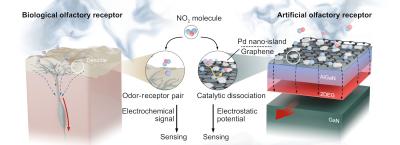Researchers at the University of Virginia, Ajou University and Soongsil University have developed an AI-powered system that mimics the human sense of smell to detect and track toxic gases in real time. Using advanced artificial neural networks combined with a network of sensors, the system quickly identifies the source of harmful gases like nitrogen dioxide (NO₂) that poses severe respiratory health risks.
Schematic of biological and artificial olfactory receptor. Biological receptors interact with odor molecules through specific binding, whereas artificial receptors use catalytic dissociation by Pd nano-islands for selective gas molecule adsorption on graphene surfaces. Image credit: Science Advances
The artificial olfactory receptor features nano-islands of metal-based catalysts that cover a graphene surface on the heterostructure of an AlGaN/GaN two-dimensional electron gas (2DEG) channel. Catalytically dissociated NO2 molecules bind to graphene, thereby modulating the conductivity of the 2DEG channel and allowing the system to detect gas leaks with extreme sensitivity.
“Nano-islands of metal catalysts are tiny clusters of metal particles deposited on a surface, such as graphene, that enhance chemical reactions by increasing the surface area for gas molecules to interact, enabling precise detection of toxic gases,” said Yongmin Baek, a research scientist in the Department of Electrical and Computer Engineering who is leading the R&D for the sensors.
Kyusang Lee, associate professor of electrical and computer engineering and materials science engineering, and one of the lead researchers on the project, explains, "By integrating AI with state-of-the-art gas sensors, we’re able to pinpoint gas leaks with unprecedented accuracy, even in large or complex environments. The artificial olfactory receptors are able to detect tiny changes in gas concentrations and communicate that data to a near-sensor computing system, which uses machine learning algorithms to predict the source of the leak."
The system’s artificial neural network analyzes data from the sensors in real-time, based on the optimized sensor placement to ensure coverage and efficiency of system. This optimization is enabled by a “trust-region Bayesian optimization algorithm,” a machine learning technique that breaks down complex problems into smaller regions to find the most efficient sensor positions. This ensures fewer resources are used while providing faster and more accurate gas leak detection.
Electrical and computer engineering Ph.D. student Byungjoon Bae adds, "Our AI-powered system has the potential to make industrial settings, urban areas and even residential buildings safer by constantly monitoring air quality. It’s a major step forward in preventing long-term health risks and protecting the environment."
